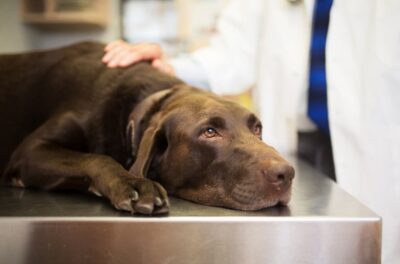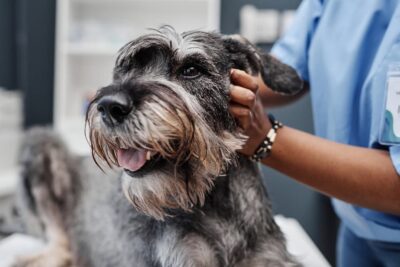Lipomas in Dogs

Overview
- A lipoma is a very common, usually benign, mass most often located under a dog’s skin.
- Any lump or bump that you discover on your pet should be examined by your veterinarian.
- Since lipomas are usually benign, you may just want to keep an eye on the mass and alert your veterinarian if it grows.
- Because there is no known specific cause of lipomas in dogs, there is also no known prevention.
As dogs age, it’s not uncommon for them to develop lumps and bumps over their body. While petting your dog, you may come across a lump that just happened to pop up, that is under the skin and feels a bit soft and squishy.
Many times, these tumors are benign growths called lipomas. Lipomas are fatty masses that occur in all types of breeds, ages, and types of dogs.
Lipomas are common and often not worrisome, but any mass found on your pet should be examined by your veterinarian.
Here’s everything you need to know about lipomas in dogs, from causes and symptoms to diagnosis and treatment.
What is a Lipoma?
A lipoma is a very common, usually benign, mass most often located under a dog’s skin. It is made up exclusively of fat cells.
Lipomas can occur at any age, though they are more common in middle-aged to older dogs. Aging dogs may develop many lipomas over the course of their lifetime.
These tumors are usually benign, or non-cancerous, and therefore do not metastasize, or spread, to other parts of the body or tissues. That means that most lipomas cause no harm to your pet. However, any mass should be tested to know for sure, rather than just assuming it’s benign.
There are a few types of lipomas that can cause illness, so diagnostics should always be performed by your veterinarian for proper identification. These include:
Liposarcomas: Rare cancerous tumors of the connective tissue that resemble fat cells under the microscope.
Infiltrative lipomas: Masses made up of fat cells that do not metastasize but rather infiltrate the surrounding tissues of the tumor. These can make it difficult or painful for your pet to move normally or compromise organ function.
Necrotic lipomas: Rarely lipomas may form in the abdomen or chest of a dog, where they may go unnoticed for long amounts of time. This may cause them to develop into necrotic lipomas meaning that the cells of the mass die and can lead to infection and inflammation.
What Causes a Lipoma in Dogs?

There is no known specific cause of lipomas in dogs. The masses are a mutation of fat cells and may be due to genetics or just how the cells grow. Certain breeds may be more predisposed to lipomas than other breeds. These include:
- Labrador Retrievers
- Weimaraners
- Doberman Pinschers
Lipomas also tend to occur in dogs who are overweight, especially females, as they age.
Symptoms of Lipomas in Dogs
Lipomas are usually discovered by owners when they are petting their dog, or when the lumps become large enough to see. Since they are primarily found under the skin, they may go unnoticed in long-haired dogs or if they are in obscure areas, such as the armpit.
You will usually notice a round, soft, squishy, isolated, freely moveable mass under your dog’s skin. It may start out small, but may grow, sometimes rather quickly. A lipoma can grow quite large, so be sure to have it examined by your veterinarian as soon as you find one.
Lipomas are not painful and may only cause discomfort if they become so large or are in a location that they affect a dog’s range of motion. For instance, if a lipoma is located in the armpit, and it becomes very large in size (think grapefruit sized), it may inhibit movement of the front leg.
Any mass on the limbs or the tail should be evaluated early and surgery considered because surgical removal is difficult in these locations if the mass grows.
Diagnosing Canine Lipomas

Any lump or bump that you discover on your pet should be examined by your veterinarian. There are many different types of masses and different levels of concern associated with them. And although a lump may look like a lipoma, it may not be. For example, mast cell tumors may look and feel similar to lipomas as can abscesses and burrowing parasites.
A fine needle aspirate will be performed, where your veterinarian will obtain a few cellular samples with a needle, which can then be examined microscopically to determine what type of cells the mass is made up of. Fine needle aspirates may be inconclusive, though, due to the small sample size.
If the fine needle aspirate is non-diagnostic, a punch biopsy may be performed, where your veterinarian can obtain a small sample of tissue from the tumor, and have it examined pathologically at the lab. This may give a more definitive diagnosis.
Many times, your veterinarian may suggest surgically removing the entire tumor and sending it out for histopathology. This is the best option, as the entire mass can be examined and tested.
And again, although it may look like a lipoma, even after removal, the trouble is, looks may be deceiving. Any mass worth removing is worth testing.
How to Treat Lipomas in Dogs

If the suspicious mass in your dog has been diagnosed as a lipoma, be it by fine needle aspirate or biopsy, then there are a few different treatment options.
The first is to do nothing and watch the mass. Since lipomas are benign, you may just want to keep an eye on the mass and alert your veterinarian if it grows. Many times, they will only need to be removed if they grow too large, or if they begin to affect mobility in any way.
Otherwise, if surgery is indicated, removal is curative. Most lipomas are encapsulated and easily removed in full, not needing any additional treatment. But this may depend on the size of the mass, where it is located, and if it has infiltrated the surrounding tissues.
Besides surgical excision, a few other alternative treatments have been explored, such as steroid injections and laser therapy, though these methods have not been proven to help at this time.
Surgical treatment options should be discussed with your veterinarian, as costs may range from a few hundred dollars to over a thousand, depending on the size of the mass, the age and health status of your dog, and which diagnostics are necessary.
How to Prevent Lipomas in Dogs
Because there is no known specific cause of lipomas in dogs, there is also no known prevention. Because they often occur in overweight dogs, it may be helpful to maintain your dog’s healthy weight and lifestyle.









